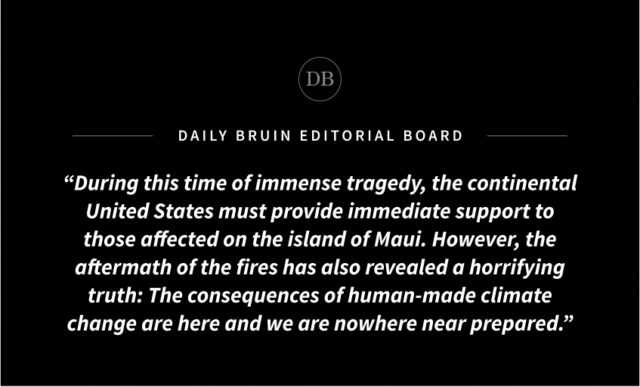This post was updated Aug. 27 at 7:22 p.m.
The human toll of the wildfires in Lahaina, on the Hawaiian island of Maui, has been utterly devastating.
Hawaii officials confirmed 115 people have been reported killed in the fires. Two weeks later, authorities are searching for 388 residents who are yet to be accounted for.
More than 2,200 buildings – around 86% of which were houses and other residences – were destroyed as over 2,100 acres burned. Current estimates suggest it will take nearly $5.5 billion to repair the damage to the region.
During this time of immense tragedy, the continental United States must provide immediate support to those affected on the island of Maui.
However, the aftermath of the fires also revealed a horrifying truth: The consequences of human-caused climate change are here, and we are nowhere near prepared.
Driven by the dramatic rise in carbon emissions since the Industrial Revolution, wildfires are growing on a global scale with mortal consequences.
As the smoke clears over Lahaina, the responsibility for one of the deadliest fires in this country’s history lies with government authorities who underestimated the danger the fires posed and the colonial legacy of Hawaii’s agricultural and economic exploitation by corporate interests.
Because of the high potential for natural disasters in Hawaii, the state’s islands have the largest and most comprehensive system of early alert sirens on the planet.
But as the fires raged, these sirens were never activated. With power cut off to the area and fire spreading rapidly, many survivors reported that they had no advance warning and had to evacuate by themselves as the fires reached their neighborhoods.
On Aug. 17, head of the Maui Emergency Management Agency Herman Andaya resigned, allegedly on the basis of health concerns. MEMA is responsible for operating the 80 emergency sirens on Maui, none of which were turned on as fires swept across the island. This accentuated the lack of clear governmental action and planning for such an emergency.
The fires themselves were also fed in part by several invasive grass species brought to Hawaii as food for livestock by European and later American colonists in the late 18th and early 19th centuries.
In some sense, the fires themselves are a product of Hawaii’s colonial exploitation, a legacy which continues into the present day as shown by reports of speculators seeking to buy lands from survivors in the region following the wildfires.
Allegations of negligence have also been directed at Hawaiian Electric, the utility company that delivers 95% of all electricity on the islands of Oahu, Maui, Hawaii, Lanai and Molokai.
Eyewitness accounts and video footage captured by residents seem to point to sparking power lines, which were toppled by intense winds driven partly by Hurricane Dora, as the cause of the fires.
The utility company is now the subject of several lawsuits, including from Maui County, and appears to be on the verge of restructuring through bankruptcy.
For many Californians, this story is eerily reminiscent of the 2018 Camp Fire, which began after a sparking power line ignited dry grass in Butte County in northern California.
85 people were killed during that fire, the deadliest wildfire toll in recent U.S. history until this month. Following the fire, Pacific Gas and Electric Company, the California-based private utility, was similarly sued by survivors and families of the fire’s victims.
In 2019, after the utility’s parent company made an unsuccessful effort to declare bankruptcy to avoid paying damage claims related to the fires, PG&E was ultimately forced to settle these lawsuits, agreeing to pay $13.5 billion in damages to victims of the Camp Fire and a series of other fires in the region for which PG&E was found to be responsible.
In 2020, the company pleaded guilty to 84 counts of involuntary manslaughter in the fires and was forced to pay a $3.5 million fine. While the settlement and the plea might represent some sense of closure for the communities that this fire destroyed, this result did not substantially affect how other U.S. utilities operated their wildfire safety programs.
In allowing PG&E and its executives to pay the way out of criminal responsibility for the wildfires, it’s clear that California did not hold those most responsible for the fires accountable, a mistake that Hawaii must not repeat.
With peak wildfire season expected to last until October in California, it’s important to pay attention to the lessons learned from the recent Maui fires and past devastating fires. Although California has shown improvements in issuing early and comprehensive alerts, a long-term strategy is necessary. Measures such as burying power lines are essential because of the increasing frequency and predictability of wildfire seasons.
The horror and sorrow in the aftermath of the Lahaina fire must be a warning to the U.S. of today because it may very well come to represent the U.S. of tomorrow.
It’s clear that this catastrophe underscores the need for enhanced governmental organization and preparedness in the face of more frequent disasters fueled by global warming.
We know there is no alternative.


Comments are closed.